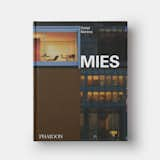Without Ludwig Mies van der Rohe (1886-1969), there would not have be the International Style we know today as the impetus for mid-century modernism. Born in Aachen, Germany, Mies (who was born Ludwig Mies and adopted his mother's maiden name, Rohe, in 1921) worked, in his early years, in the office of Peter Behrens, which employed Le Corbusier, Walter Gropius, Hans Meyer, and Peter Grossman at the same time as well. Inspired by the work of Karl Friedrich Schinkel, Mies lay his first monumental foundations in the early 1920s with an office building and skyscraper in Berlin (though, of course, they could have been placed anywhere), both sheathed in glass. His 1929 Barcelona Pavilion--from which also comes the Barcelona chair produced by Knoll--became iconic of the International Style and its use of modern materials (like glass, steel, and, here, marble and travertine) meant for any and all locations. Like many German modernists, Mies immigrated to the United States during the Nazi reign and found his home in Chicago. In the U.S., he created American masterpieces like the S.R. Crown Hall at the Illinois Institute of Technology, the Seagram Building in New York, and the Farnsworth House, just outside of Chicago. Though he passed away in 1969, his legend, like his influence, continues to live loudly.



